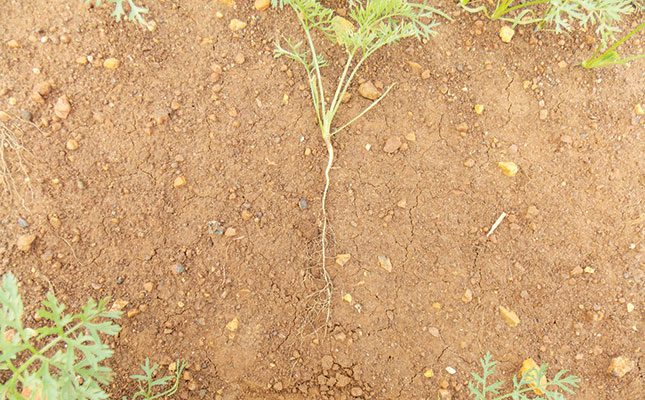
Photo: Bill Kerr
To get a better understanding of the optimal irrigation that is required, we need to take a look at the carrot root system. Most vegetable crops have a relatively shallow root system compared with carrots.
When I tell farmers that carrot roots can even exceed a depth of 2m, they are very sceptical.
READ The main types of irrigation
However, we can’t expect to harvest carrots of 2m in length, but it is the fine roots that source water and nutrients which have the potential to reach this depth.
When I was actively farming, I decided to see for myself how deep the carrot roots reached.
I dug a profile hole in the middle of a land of carrots that were not too far off maturity. I did find that the roots had reached 2m.
I am told that they can reach even deeper. Most carrot farmers do not exploit this potential and irrigate more or less the same as they do for other vegetables.
So what is the advantage of forcing roots to go so deep? The first advantage is that the crop can source nutrients from the soil right down to this level. Many nutrients are leached to deeper layers, which can be recovered by the carrots.
The next advantage is water. Irrigation is becoming increasingly expensive due to pumping costs, and with a deeper root system the crop can source water from a far greater profile.
The deeper moisture may be from our irrigation having wetted beyond the level sourced by other vegetables, and also from when we get penetrating rain.
Irrigation strategy
Usually by forcing roots to penetrate deeper, we get longer, more marketable carrots and often also with a better colour.
I had a farmer client who planted his carrots under a pivot, and when I told him about my irrigation strategy, he was sceptical and continued his irrigation as for other vegetables.
READ Deeper roots, better carrots
When I visited him later, he was not happy with the length of his carrots.
Knowing that the windward side of the pivot would likely have had less water on occasions and that there had been fairly heavy rain on occasions, I took him to the edge, and to his amazement he found the length that he had been hoping for.
Irrigate deeper incrementally
Carrot roots will not go deeper than they need to grow, so we have to apply practices to force them to comply with our strategy.
In other words, we start off with light irrigations and then irrigate deeper incrementally with greater gaps between irrigations to force the roots through stress to penetrate deeper in search of water.
One can see this stress by the leaves becoming duller, with less sheen. When I grew carrots commercially, I would at the appropriate time have the sprinklers on in the same place for the whole day, and then not irrigate for a month or so.
I left the Lowveld and moved to a farm on the Highveld due to health reasons. My boss at the time went into a land that was approaching maturity and could not pull a carrot out.
He went to the shed for a fork and found the carrot surfaces were showing the profile of the soil. He rushed to me in a panic and I had difficulty convincing him there was no problem.
I then gave regular irrigations for two weeks, and when my boss delivered to the supermarket, they declared the carrots to be the best ever from his farm.
Bill Kerr is a vegetable specialist and breeder.










